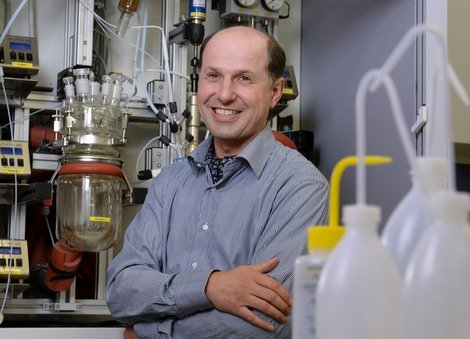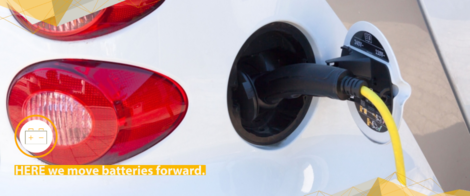Self-healing polymer extends the lifetime of electric car batteries
Researchers from Halle are developing materials for a special diagnostics and repair system

Electric cars help to improve air quality in cities. During the production of the cars and, in particular, the batteries, emphasis is placed on their environmental footprint and sustainability, not only their performance. Researchers from Martin Luther University Halle-Wittenberg are developing self-healing polymers that can increase the storage capacity of lithium-ion batteries and, at the same time, extend their useful life.
As the market for electric vehicles grows, the batteries used to store energy in these vehicles are being produced in larger numbers. Lithium-ion batteries have become the technology of choice and will help to ensure that electric cars have an acceptable environmental footprint. They are extremely compact, provide high levels of performance and have long been used in smartphones, tablets, laptops and digital cameras. Now these rechargeable batteries are being installed in electric cars. However, the short intervals between charges present a problem for consumers.
“Our researchers have been focusing on the properties of the materials used in lithium-ion batteries with the aim of developing systems with a higher storage capacity and longer service life”, says Professor Wolfgang Binder from the Institute of Chemistry at Martin Luther University (MLU) Halle-Wittenberg. His work has links with global issues, such as the environmental and social standards in the countries where lithium is mined. A growing number of car manufacturers are aiming to take advantage of researchers' expertise in the production of lithium-ion battery cells. They are concerned not only about production costs, but also about sustainability and resource efficiency.
Humanity's dream of indestructible materials
The researchers at the MLU Institute of Chemistry can bring specialist knowledge to bear regarding the useful life of materials. The group headed by Wolfgang Binder is working on the development of functional polymers. As the professor explains: “Polymers are the long-chain molecules that materials such as plastics are made of.” Their structure, arrangement and composition can be changed using chemical means to such an extent that they acquire new properties. “We want to move one step closer to humanity’s dream of materials that don’t wear out”. He laughs, but remains firmly grounded in reality. By developing materials that can independently identify the smallest structural defects and then repair them, his group of researchers is attracting interest from specialists in this field around the world.
For instance, the discoveries made by the team of chemists from Halle-Saale are of interest to the EU “BAT4EVER” research project. Together with partners from research institutions and companies all over Europe, they are overcoming the challenge of developing technologies that slow down the ageing process of lithium-ion batteries and, at the same time, improve their performance. According to Binder, drivers want the expensive batteries in their electric cars to have as long a life as possible. But they also want to be able to charge them in only five minutes at a charging station, just like traditional petrol users.
Diagnostics and healing
However, increasing the battery performance and reducing the charging times come with one complication: “The faster the battery is charged and discharged, the faster it ages”, says Binder. To put it simply, the volume of the materials inside the battery changes during the charging and discharging cycles. The materials expand and contract, and this happens more frequently during fast charging processes. As a result, cracks form in the battery electrodes which ultimately cause premature degradation of the electrodes and the electrolyte. This reduces the capacity of the battery which, as it grows older, becomes increasingly difficult to charge.
A "forever battery" or BAT4EVER must therefore be made of materials that can compensate for these changes in volume. The EU project is developing a diagnostics and repair system for identifying and rectifying damage at an early stage. The functional materials developed by Binder’s team of researchers play an extremely valuable role in this respect. They include a reversible adhesive that “holds together” stressed electrodes during the charging and discharging process. According to Binder, this is an adhesive gel with chemical bonds that break and then re-form as the volume of the materials changes. The gel acts as a protective layer which fills even the tiniest cracks in the electrodes and prevents the damage from worsening.
The "forever battery"
“As part of the EU project, we want to assess the impact that the self-healing system in the electrolyte has on the operation of the battery”, says the professor. He explains that the processes inside a battery are similar to those inside a clock. If individual gears are changed, it is important to investigate carefully whether this has a positive effect on the overall process. The same thing applies to changes in the properties of materials.
Wolfgang Binder is focusing on the entire process right through to the final phase, which involves recycling the electric car batteries. As he explains, this is a wide-ranging field of research involving complex problems. From this perspective too, it is beneficial for the batteries to have a longer service life.
Author: Kathrain Graubaum/IMG Saxony-Anhalt

In electromobility, the battery is of central importance as an energy storage device.
Saxony-Anhalt is ideally positioned as a location for battery cell production in Germany - from battery chemicals and material production to battery development and testing.
>> Find out more about battery cell manufacturing in Saxony-Anhalt
